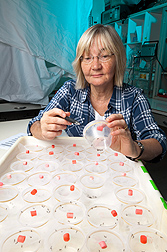This page has been archived and is being provided for reference purposes only. The page is no longer being updated, and therefore, links on the page may be invalid.
| Read the magazine story to find out more. |
|
|
Baiting Mosquitoes with Knowledge and Proven Insecticides
By Sandra AvantNovember 13, 2012
While one team of U.S. Department of Agriculture (USDA) scientists is testing the effectiveness of pesticides against mosquitoes, another group is learning how repellents work.
At the Agricultural Research Service (ARS) Center for Medical, Agricultural and Veterinary Entomology (CMAVE) in Gainesville, Fla., entomologist Sandra Allan is using toxic sugar-based baits to lure and kill mosquitoes. Allan and her CMAVE cooperators are evaluating insecticides and designing innovative technology to fight biting insects and arthropods. ARS is USDA's principal intramural scientific research agency.
Allan studied 10 different commercial pesticides that contain additives that enable the pesticides to be dissolved in water and ingested by mosquitoes. Pesticides were combined with a sucrose solution and fed to females of three mosquito species that transmit pathogens such as West Nile virus and arboviruses. While only females feed on blood, all mosquitoes need to feed on sugar and will potentially be attracted to—and ingest—the toxic sugar bait.
Compounds from five different classes of insecticide-active ingredients—pyrethroids, phenylpyroles, pyrroles, neonicotinoids and macrocyclic lactones—were found to be toxic against all three mosquito species, Culex quinquefasciatus, Anopheles quadrimaculatus and Aedes taeniorhynchus.
Scientists at the ARS Henry A. Wallace Beltsville Agricultural Research Center in Beltsville, Md., are learning more about how mosquito repellents work. Entomologist Joseph Dickens and post-doctoral research associate Jonathan Bohbot found that several repellents—DEET, 2-undecanone, IR3535 and picaridin—affect specific odorant receptors in mosquitoes differently, thereby scrambling the insect's ability to detect chemical attractants.
In experiments, they injected frog eggs with odorant receptor genes. Molecular mechanisms within the eggs allowed these receptors to be reproduced in the outer cell membrane of the egg. Researchers then placed electrodes in the outer cell membrane and recorded electrical responses of the odorant receptors to chemical solutions.
Read more about this research in the November/December 2012 issue of Agricultural Research magazine.

